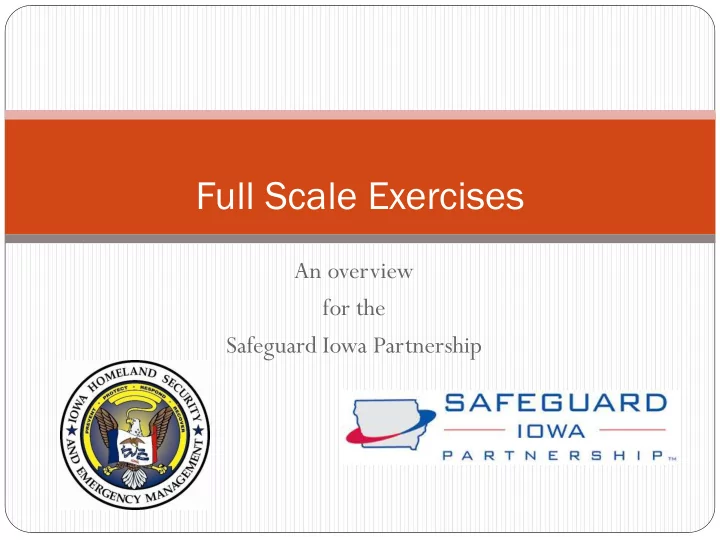

Full Scale Exercises An overview for the Safeguard Iowa Partnership
Using HSIN Connect Please turn on your computer speakers to listen to the audio. This webinar is being recorded and a copy will be available on the Safeguard Iowa Partnership website for future viewing. At the end of the presentation the presenters will take questions. To submit a question use the Chat feature available on the left-hand side of your screen.
Brought to you by Safeguard Iowa Partnership in collaboration with our partner Iowa Homeland Security and Emergency Management.
Welcome and Introductions John Halbrook – Steve Warren – Exercise Planner HSEMD Exercise Planner HSEMD
Webinar Objectives Exercise philosophies and methodologies Describe the purposes and characteristics of a functional Describe the steps in designing and conducting a functional exercise. Review documents that can be used to support functional exercises Moving forward from functional exercises
HSEEP HSEEP = Homeland Security Exercise Evaluation Program A nationally recognized methodology Adopted from federal, military and private sector exercise programs Established based upon best practices Common structure and terminology
Progressive Exercising Broad commitment: Multiple groups involved in planning, preparation, and execution. Careful planning: Each exercise carefully planned to achieve identified goals. Increasing complexity: Increasingly complex exercises build on each other until mastery is achieved.
Goals and Objectives We start with goals not Scenarios Goals will tell us the scenarios that fit our exercise If we start with the scenario we don’t always fit in all of our goals Example Identify which staff will set up an alternate work site during a COOP event. Identify IT connectivity gaps in our emergency plan Evaluate the plans to mobilize the coordination center during an emergency.
The Full Scale Exercise Operations Based
Unit Objectives Describe the purpose and characteristics of a full-scale exercise. Explain how designing a full-scale exercise differs from designing a functional exercise. Identify planning considerations for site selection and scene management for a full-scale exercise.
The Full-Scale Exercise Highly realistic — resources deployed Lengthy, complex, “on location” Interactive
Why Conduct a Full-Scale? Tests ability to perform many functions at once Tests total coordination Reveals resource capabilities and shortfalls Expands program scope and visibility Attracts public attention and raises credibility Satisfies regulatory requirements
Exercise Requirements Exercise experience Total commitment Support from key officials Adequate physical facilities (EOC, command posts) Communication facilities Financial resources Planning and logistics
Controller(s) If more than one controller, chief controller takes the lead Manages the exercise Responsible for starting on schedule Designates exercise control point
Participants Policy makers Coordination personnel Operations personnel Field personnel
Simulators Volunteers who play the part of victims May wear makeup Act injured, unconscious, hysterical, dead, etc.
Evaluators, Safety Officer Evaluators: Observe action. Keep log of significant events. May videotape action. Safety Officer: Analyzes exercise from safety perspective. Ensures safe conduct of exercise. Has authority to terminate activities.
How It Works: Start-Up Announced or “no notice”— notification through normal channels Responders go to event site — visual narrative Decision makers go to EOC Command posts set up as needed
How It Works: Action Action occurs: In the EOC. At field sites and command posts. Field and command post action provides input to EOC. Field units coordinate with command posts. Action is sustained through messages, actions, and responses.
How It Works: Locations Main event site depends on scenario Secondary event sites (hospitals, shelters, etc.) EOC: Policy and coordination Information Direction and control
Designing Full-Scale Exercises Design difficulties — logistics and design Start small, build up Use entire 8-step process, with differences: Things replace words Visual narrative replaces written scenario Requires deeper analysis and greater attention to detail
Applying the Design Steps Steps 1 – 4: Deeper analysis, greater attention to detail Step 5: Lengthy narrative unnecessary Step 6: Major and detailed events: Many are simulated with victims, props Cannot be random or haphazard Step 7: Expected actions: Based on objectives Detailed list is needed
Applying the Design Steps Step 8: Messages Initial messages: Visual Prescripted messages move action along Anticipate the unexpected Be flexible
Special Considerations Walk the site, evaluating: Site selection. Scene management. Personnel and resources. Response capability. Safety and legal liability. Emergency call-off. The media.
Site Selection Credible emergency Realistic without interfering with normal traffic or safety Enough space for victims, responders, observers, vehicles
Scene Management Logistics Creation of believable emergency scene Number of victims Props and materials Number of controllers
Personnel and Resources Participants and volunteers Equipment and fuel Materials and supplies Expenses Response capability: Maintain enough staffing for real emergencies
Safety and Liability Designated safety officer with authority to terminate Address safety in: Exercise design. Preexercise briefing. Simulator and evaluator packets. Examine field locations, resolve all hazards Provide call-off procedures Research liability
The Media Exercises draw media attention. Take advantage of attention to: Gain support. Increase realism. Make allowances for: Observers. Public information people.
Unit Summary In Unit 7, we: Reviewed characteristics of a full-scale exercise. Examined how the design process is applied to full-scale exercises. Identified local design considerations. Next: Exercise Evaluation
Tools and Templates HSEEP/Exercise Design class January 24-27 2012 October 16-19 th 2012 Iowa Homeland Security Emergency Management http://www.iowahomelandsecurity.org/ Local Emergency Management Professionals HSEEP website https://hseep.dhs.gov Exercise document templates https://hseep.dhs.gov/hseep_Vols
Thank You John Halbrook Steve Warren John.Halbrook@iowa.go Steve.Warren@iowa.gov (515) 725-3280 (515) 725-3201
Recommend
More recommend